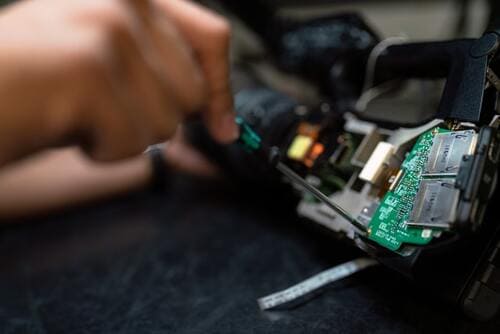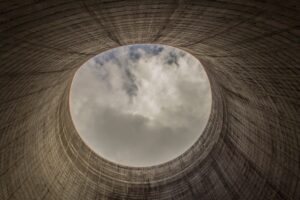Fiber optic sensing technology has proved to be an effective method in well and reservoir management. Fiber optic sensors constantly track temperature changes along the wells at specified intervals and collect all the data.
This technique is also compliant with the other technologies such as Steam Assisted Gravity Drainage (SAGD).
What is Steam Assisted Gravity Drainage?
Steam Assisted Gravity Drainage (or SAGD) is an enhanced oil recovery drilling technique that helps in extracting heavy crude oil or bitumen from oil sands deposits. Mostly, the accustomed approaches in such cases are economically inefficient. Specialists may use it in particular cases when the production is difficult. With the help of the fiber optic technology this approach becomes more cost-effective.

How does Steam Assisted Gravity Drainage work?
In short, the SAGD system’s principle is heating the heavy oil or bitumen by the steam for further extraction. For that two horizontal wells are drilled at an angle of 90 degrees to a vertical bore well. In the wells, there are two pipes, one above the other for around 4-5 meters.
At the very beginning, the cold heavy oil is essentially immobile because of the high viscosity, and it needs to be warmed up to extract it. To do so, the steam is applied. It travels through the upper well into the reservoir and expends the heat in all directions of the formation, making a steam chamber. The heat warms the bitumen and reduces its viscosity. Then the bitumen flows downward into the production well and is pumped to the surface. Both processes are going at the same time.
Current Applications of the Steam Assisted Gravity Drainage
Due to the growing level of oil consumption, the level of its development needs to be increased. Not the last role is played by the SAGD and fiber optic systems such as fiber optic sensors and fiber Bragg gratings.
Like any exploration, heavy oil production needs accurate analysis and planning, especially if there are other factors that make the production difficult. Such aspects as great depth, high temperature conditions, etc. are essential. All of these issues need to be considered. The low mobility and high viscosity make the oil producing complicated and lead to low recovery indexes. However, due to the SAGD and fiber optic technology, there is an opportunity to maximize the recovery indexes.
For SAGD technology, FBG sensors are usually applied in wells to track the steam as it moves along the wellbore. Due to the fiber optic sensors, there is an opportunity to see the data in real time. According to the achieved data, the velocity of the steam can be identified. Besides, temperature sensors can also define the speed of the heating. The accurate settings of the temperature, pressure and steam-injection rates can lead to the operational savings. All the information can be used to plan the further work of the production operations.
Fiber Optic Sensors in Downhole Monitoring
Fiber optic sensors have proved to be effective for various parameters’ monitoring in downhole applications. Most of all, distributed temperature sensing (DTS) is applied for these purposes. Distributed sensing has demonstrated good results. It has high recommendations in the oil industry. DTS can monitor well temperature all over the fiber optic cable.
Due to the modernly developed fiber optic designs and improvement of fiber optic sensing technology, a range of issues related to downhole production have been solved. However, the harsh environmental conditions in the downhole can still bring some problems to the fiber optic sensors.
The sensors still need to cope with hydrogen in the severe environmental conditions. It has a great impact on the optical fibers. Firstly, it can cause pressure and temperature errors. The appearing errors are connected to the hydrogen diffusion into the microstructure and to the changes of the refractive index when hydrogen penetrates into micro holes and fiberglass. So the hydrogen leads to the additional Bragg wavelength shift.
With this in mind, specialists are constantly developing fiber optic monitoring systems based on fiber Bragg grating technology.
Advantages and disadvantages of the SAGD
SAGD has played a crucial role in the rapid development of the oil resources. However, as everything, this method has some pros and cons that should be taken into account.
Most Common Disadvantages for SAGD technology
- Firstly, as any other technology, SAGD has its restrictions. It is not well-suited for every production area with heavy oil. It has several aspects to be fulfilled, like homogeneous and relatively thick reservoirs.
- Secondly, high water and fuel consumption. To work effectively, SAGD needs a large amount of water and natural gas. Both of them are used in the process of steam production. That’s why the energy consumption is high but worth it. When all these conditions are satisfied, SAGD technology can be used. Moreover, the specialists advise using deep water sources that are not appropriate for consumption or agricultural uses. In fact, the majority of deployments’ developers follow this recommendation for environmental protection.
- Thirdly, some think that SAGD technology is an expensive tool for oil production. However, specialists consider this technology as a superior alternative to reduce the high expenses and at the same time increase productivity. The reason for the cost reduction is that less horizontal wells are required to be drilled.
- Fourthly, concerns about an environmental effect of the steam assisted gravity drainage (SAGD) are still a topic of discussion. However, according to the statistics, over the last 20 years the environmental analysis is getting better. It is obvious that the production of the crude bitumen and oil cause environmental consequences, but due to the development of modern cleaner extraction technologies, the situation is improving.
The Main Advantages of the SAGD technology
The main benefit of the whole SAGD technology is the improved steam-oil ratio and high ultimate recovery. Besides, the DTS systems help in optimization of the oil and bitumen production.
The other SAGD advantage is the constant evolution. Every next project makes a great contribution and brings new ideas and experiences. Meanwhile, the diversity of newly developed methods leads to new approaches to different types of oil fields.
So there are other modified types of SAGD technique:
- Shaft and Tunnel Access (SATAC);
- Single Well SAGD (SW-SAGD);
- Multi-drain SAGD;
- Fast-SAGD;
- Enhanced Steam Assisted Gravity Drainage (ESAGD).
The SAGD was firstly implemented in Canada, where there are the largest reservoirs of crude bitumen. This allowed to advance the recovery factors in excess of 50%.
SAGD (steam assisted gravity drainage) well temperature monitoring provide:
- Temperature profile control of injection and production wells;
- Determination of inflow (injection) intervals of the fluid;
- Determination of the fluid level in the well and perforation intervals;
- Identification of issues in the well.
Plus, as any fiber optic technology, distributed temperature sensing for SAGD offers:
- Maximum protection of the cable against chemical and physical effects;
- Longer service life;
- Convenience and speed of the installation;
- Operations in the well without the extraction of the cable sensor.
The SAGD wells have implemented all the advantages of fiber optic sensing. FBG sensors offer real-time, precise temperature measurements along the fiber optic cable in the wellbore. Fiber optic solutions allowed us to monitor the objects that were unapproachable before. For example, fiber optic sensors with extended temperature range were applied in the oil wells for temperature control during oil production using SAGD technology.
Steam assisted gravity drainage is commonly believed to be applied for complex deployments. It aims to make the process simpler. And the fiber optic technology is good at helping it. However, the specialists should discuss and decide how fiber optic technology can fit into the development at the planning stage. Fiber optic solutions may simplify the production process.
Optromix is a fast-growing vendor of fiber Bragg grating (FBG) product line such as fiber Bragg grating sensors, for example, fbg strain sensors, FBG interrogators and multiplexers, Distributed Acoustic Sensing (DAS) systems, Distributed Temperature Sensing (DTS) systems. The company creates and supplies a broad variety of fiber optic solutions for monitoring worldwide. If you are interested in structural health monitoring systems and want to learn more, please contact us at info@optromix.com







 According to the researchers from the American university, the faster specialists can detect thermal shifts the faster they can prevent disruptive quench in the HTS magnets for fusion devices in power plants. That is why scientists hope to solve this issue with the help of newly developed fiber optic solutions.
According to the researchers from the American university, the faster specialists can detect thermal shifts the faster they can prevent disruptive quench in the HTS magnets for fusion devices in power plants. That is why scientists hope to solve this issue with the help of newly developed fiber optic solutions. During the last 60 years, fiber optic technology has been applied to improve the efficiency of developed systems in various spheres like medicine, vehicles, and other industries. Modern fiber optic solutions expand the abilities by implementing levels of data and sensing technology in the energy, medical field, and even aerospace. There are various fiber optic solutions that help researchers improve their development and make new discoveries in science.
During the last 60 years, fiber optic technology has been applied to improve the efficiency of developed systems in various spheres like medicine, vehicles, and other industries. Modern fiber optic solutions expand the abilities by implementing levels of data and sensing technology in the energy, medical field, and even aerospace. There are various fiber optic solutions that help researchers improve their development and make new discoveries in science. The sensing technology market has a rapid growth in the last few decades. Most of all, this is explained by the main advantages like small size, environmental and electrical immunity, and distribution capabilities. The new units of FBG sensors and fiber optic cables are valuable instruments for monitoring industrial processes and infrastructure. That’s why fiber Bragg grating (FBG) sensors are applied in many different spheres.
The sensing technology market has a rapid growth in the last few decades. Most of all, this is explained by the main advantages like small size, environmental and electrical immunity, and distribution capabilities. The new units of FBG sensors and fiber optic cables are valuable instruments for monitoring industrial processes and infrastructure. That’s why fiber Bragg grating (FBG) sensors are applied in many different spheres.